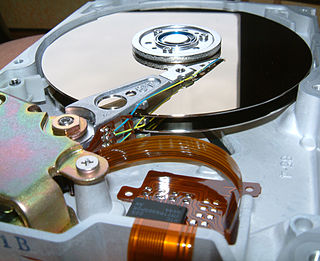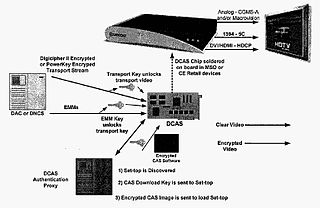
TiVo Corporation, formerly known as the Rovi Corporation and Macrovision Solutions Corporation, was an American technology company. Headquartered in San Jose, California, the company is primarily involved in licensing its intellectual property within the consumer electronics industry, including digital rights management, electronic program guide software, and metadata. The company holds over 6,000 pending and registered patents. The company also provides analytics and recommendation platforms for the video industry.

In mass communication, digital media is any communication media that operates in conjunction with various encoded machine-readable data formats. Digital content can be created, viewed, distributed, modified, listened to, and preserved on a digital electronic device, including digital data storage media and digital broadcasting. Digital is defined as any data represented by a series of digits, and media refers to methods of broadcasting or communicating this information. Together, digital media refers to mediums of digitized information broadcast through a screen and/or a speaker. This also includes text, audio, video, and graphics that are transmitted over the internet for viewing or listening to on the internet.
Video on demand (VOD) is a media distribution system that allows users to access videos, television shows and films without a traditional video playback device and a typical static broadcasting schedule. In the 20th century, broadcasting in the form of over-the-air programming was the most common form of media distribution. As Internet and IPTV technologies continued to develop in the 1990s, consumers began to gravitate towards non-traditional modes of content consumption, which culminated in the arrival of VOD on televisions and personal computers.

A home theater PC (HTPC) or media center computer is a convergent device that combines some or all the capabilities of a personal computer with a software application that focuses on video, photo, audio playback, and sometimes video recording functionality. Since the mid-2000s, other types of consumer electronics, including game consoles and dedicated media devices, have crossed over to manage video and music content. The term "media center" also refers to specialized application software designed to run on standard personal computers.
Streaming television is the digital distribution of television content, such as television shows and films, as streaming media delivered over the Internet. Streaming television stands in contrast to dedicated terrestrial television delivered by over-the-air aerial systems, cable television, and/or satellite television systems.

Vizrt, short for Visualization in Real-Time or Visual Artist, is a Norwegian company that creates content production, management, and distribution tools for the digital media industry. It's products includes applications that create real-time 3D graphics and maps, visualised sports analysis, media asset management, and single workflow solutions for the digital broadcast industry.
Digital Living Network Alliance (DLNA) is a set of interoperability standards for sharing home digital media among multimedia devices. It allows users to share or stream stored media files to various certified devices on the same network like PCs, smartphones, TV sets, game consoles, stereo systems, and NASs. DLNA incorporates several existing public standards, including Universal Plug and Play (UPnP) for media management and device discovery and control, wired and wireless networking standards, and widely used digital media formats.
NBCUniversal Media Group is the television and streaming arm of NBCUniversal, and the direct descendant and successor of the former division NBCUniversal Television Group, which existed from 2004 to 2019.

Discovery Digital Networks was a San Francisco based multi-channel Internet television and digital cable network that created, produced and distributed streaming television shows on niche topics. It was sold by Discovery Communications into Group Nine Media in December 2016 and, as such, no longer exists.

Digital signage is a segment of electronic signage. Digital displays use technologies such as LCD, LED, projection and e-paper to display digital images, video, web pages, weather data, restaurant menus, or text. They can be found in public spaces, transportation systems, museums, stadiums, retail stores, hotels, restaurants and corporate buildings etc., to provide wayfinding, exhibitions, marketing and outdoor advertising. They are used as a network of electronic displays that are centrally managed and individually addressable for the display of text, animated or video messages for advertising, information, entertainment and merchandising to targeted audiences.
The Technology and Engineering Emmy Awards, or Technology and Engineering Emmys, are one of two sets of Emmy Awards that are presented for outstanding achievement in engineering development in the television industry. The Technology and Engineering Emmy Awards are presented by the National Academy of Television Arts and Sciences (NATAS), while the separate Primetime Engineering Emmy Awards are given by its sister organization the Academy of Television Arts & Sciences (ATAS).

Downloadable Conditional Access System or DCAS was a proposal advanced by CableLabs for secure software download of a specific Conditional Access client which controls digital rights management (DRM) into an OCAP-compliant host consumer media device. The National Cable & Telecommunications Association (NCTA) proposed that DCAS be used as a substitute for physical CableCARDs, a standard also created by CableLabs for which products began appearing in August 2004 as part of industry compliance to the FCC mandate, which in turn is pursuant to the Telecommunications Act of 1996. DCAS is growing in popularity as a less expensive alternative for CableCARD, with major North American operator deployments from Cablevision and Charter. DCAS deployments can be expected to grow in the coming years, thanks to favorable regulatory view from the STELA Reauthorization Act of 2014 and FCC appointing a Downloadable Security Technical Advisory Committee, and wider support for key ladder (K-LAD) functionality from system-on-chip (SoC) vendors and set-top box manufacturers.

A digital media player is a type of consumer electronics device designed for the storage, playback, or viewing of digital media content. They are typically designed to be integrated into a home cinema configuration, and attached to a television or AV receiver or both.

Mediaroom is a collection of software for operators to deliver IPTV (IPTV) subscription services, including content-protected, live, digital video recorder, video on demand, multiscreen, and applications. These services can be delivered via a range of devices inside and outside customers' homes, including wired and Wi-Fi set top boxes, PCs, tablets, smartphones and other connected devices – over both the operator's managed IP networks as well as "over the top" (OTT) or unmanaged networks.

Content marketing is a form of marketing focused on creating, publishing, and distributing content for a targeted audience online. It is often used by businesses in order to achieve the following goals: attract attention and generate leads, expand their customer base, generate or increase online sales, increase brand awareness or credibility, and engage an online community of users. Content marketing attracts new customers by creating and sharing valuable free content. It helps companies create sustainable brand loyalty, provides valuable information to consumers, and creates a willingness to purchase products from the company in the future.
Digital rights management (DRM) is the management of legal access to digital content. Various tools or technological protection measures (TPM) like access control technologies, can restrict the use of proprietary hardware and copyrighted works. DRM technologies govern the use, modification and distribution of copyrighted works and of systems that enforce these policies within devices. DRM technologies include licensing agreements and encryption.
A smart TV, also known as a connected TV (CTV), is a traditional television set with integrated Internet and interactive Web 2.0 features, which allows users to stream music and videos, browse the internet, and view photos. Smart TVs are a technological convergence of computers, televisions, and digital media players. Besides the traditional functions of television sets provided through traditional broadcasting media, these devices can provide access to over-the-top media services such as streaming television and internet radio, along with home networking access.
Electronic sell-through (EST) is a method of media distribution whereby consumers pay a one-time fee to download a media file for storage on a hard drive. Although EST is often described as a transaction that grants content "ownership" to the consumer, the content may become unusable after a certain period and may not be viewable using competing platforms. EST is used by a wide array of digital media products, including movies, television, music, games, and mobile applications. The term is sometimes used interchangeably with download to own (DTO).
The 59th Technology and Engineering Emmy Awards was held on January 8, 2008 at the 2008 International Consumer Electronics Show in Las Vegas.

Fisher Klingenstein Ventures, LLC, doing business as FilmRise, is a New York City–based film and television studio and streaming network, which has become one of the largest independent providers of content to ad-supported streaming (AVOD) platforms, in addition to providing the largest free direct to consumer service with its 22 owned-and-operated streaming channels, the "FilmRise Streaming Network". Currently, the FilmRise Streaming Network has reported more than 31.5 million downloads in the U.S. and can be seen on Roku, Amazon Fire TV, Comcast, iOS, Android and Apple, among other platforms. FilmRise also syndicates its own digital linear channels to platforms including The Roku Channel, Samsung TV Plus, and Amazon's Freevee and Vizio.










